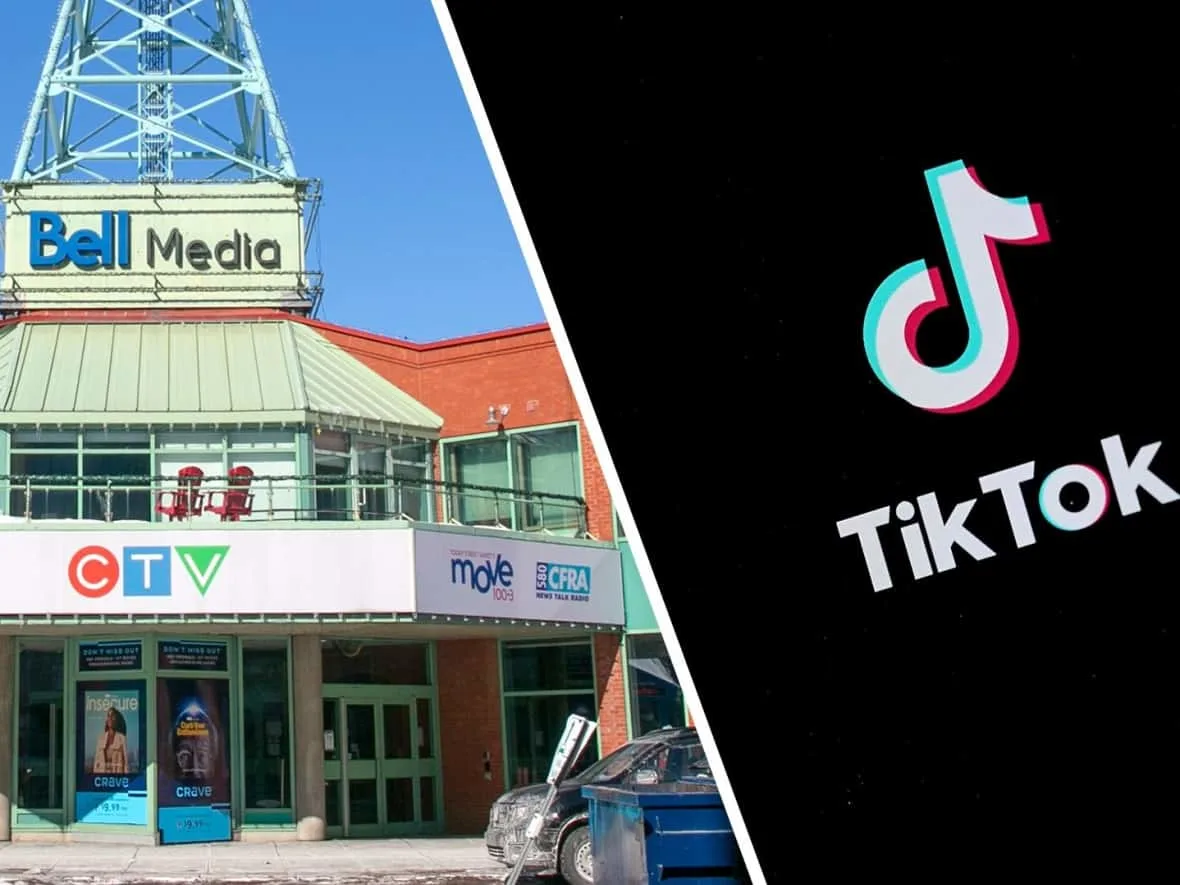TikTok is becoming a popular source for news. Can it help fill the gaps left by local TV news cuts?

TKFFF · 2024-02-22 17:39
 Canada's local TV news landscape changed drastically this month when Bell Canada cancelled a number of newscasts and eliminated journalism jobs across the country, at a time when a growing number of people are getting their news from alternative platforms like TikTok. Experts say traditional media needs to meet the audiences where they are, but caution TikTok has its limitations. (Ted Shaffrey/The Associated Press, Drew Angerer/Getty Images - image credit)
Frank Cirinna didn't necessarily set out to become someone people turn to for news headlines, but that's exactly what has happened with his popular TikTok account.
He is admittedly not a journalist — he's a full-time school teacher in the Toronto area — but his concise yet punchy videos breaking down local and national news stories, sometimes infused with his personal takes on the topics, has attracted nearly 100,000 followers to his account, @frankdomenic.
"This was a way for me to reach people who wanted to be informed but didn't want to sit down and watch the evening news or weren't traditional readers," said Cirinna.
The 30-year-old is one of many Canadian TikTokers — including former Global News journalist Rachel Gilmore and former CP24 reporter Brandon Gonez — who are turning TikTok into a favoured platform for news.
How many TV hours did each region loose to CTV cuts?
They're demonstrating that there is a demand for watching someone deliver the news when the traditional local TV news landscape is diminishing. But media experts say though some audiences have shifted to less conventional options, local TV news reporting isn't easily replaced once it disappears.
"There are, you know, people providing valuable information [on TikTok]," said Nicole Blanchett, an associate professor at Toronto Metropolitan University's School of Journalism and a former producer with CityNews.
"But how much one person can do compared to a newsroom — it's not comparable."
WATCH | Significant losses to local news coverage as Bell makes cuts, layoffs:
Pivoting to new platforms
News outlets, faced with dwindling ad revenue, have been chasing audiences to new social media platforms for some time — whether it was Facebook, YouTube or X, which was formerly known as Twitter — with varying success.
In its 2023 Digital News Report, the Reuters Institute found 69 per cent of Canadians get their news online, which includes both websites and social media, while 49 per cent said they watch TV news — a number driven by viewers 45 and up.
Facebook, at the time the research was conducted, was the most popular social media source for news, but its parent company Meta has since blocked news access for Canadian users in response to the federal government's Online News Act. X, since taken over by billionaire Elon Musk, has turned its focus away from news.
The audience for news on TikTok is small but growing. It accounted for just five per cent of news consumption in the Reuters Institute survey of 2,150 Canadians, conducted in early 2023, and the demographics, not surprisingly, tend to skew younger.
A similar Pew Research poll in the U.S. found TikTok saw the biggest growth among those who regularly get their news from social media, rising from 22 per cent in 2020 to 43 per cent last year.
WATCH | Prime minister 'pissed off' over Bell Media layoffs:
Local news losses
Local TV news, meanwhile, took a beating this month.
On Feb. 8, Bell Canada, the parent company of Bell Media and CTV, slashed journalism jobs nationwide and cancelled news programming across most of its markets.
It ceased production of weekend evening and late night newscasts across the country, except those in Toronto, Ottawa and Montreal. Toronto is the only one of its markets maintaining a weekday noon newscast.
According to a CBC News tally, the cuts amount to 48.5 hours of original local TV news programming lost across the country each week — and that's on top of many of these markets having lost a half-hour from their 5 p.m. newscasts each weeknight after CTV News launched a 5:30 national newscast on Oct. 31.
It's the "slow death by literally 1,000 and some cuts," said Canadian Association of Journalists president Brent Jolly, and reflective of "a widening chasm of information deserts across the country."
CBC is also poised to lay off 10 per cent of its workforce, citing a $125-million budget shortfall with approximately 250 jobs cut from its English service and a similar number from French-language Radio-Canada. It's not yet clear how the cuts may affect news programming.
Meeting the audience
But even in the face of cuts, news organizations must continue to adapt to meet the viewers where they are, which is largely online, Jolly said in an interview from Toronto.
He is "a bit cautious in hoping that the wave of TikTokers and social media influencers are going to be the ones to sort of fill this gap" left by cancelled local newscasts and fewer reporters.
Even though journalists and online content creators may both rely on information and footage sourced from social media or details provided by eyewitnesses, he says the degree of editorial scrutiny is far greater in a newsroom.
In a lot of cases, he says, independent news content creators are relying on the journalism already being gathered by mainstream news sources and he doesn't see as many of the independent TikTok presenters going to the scene where news is happening.
Cirinna, for his part, said he doesn't have the time or resources to do so.
The four major English-language news broadcasters — CBC News, CityNews, CTV News and Global News — are all making attempts to attract audiences by posting their news content on TikTok and have developed substantial followings.
Although their accounts may offer some content from different regions, they primarily target broader audiences and there are only a few specifically local accounts under their branding serving larger markets, such as @cbcvancouver or @ctvnewstoronto, but not smaller communities.
If there is a desire to increase a local news presence on TikTok, it will require a dedicated investment and proper resources, says Blanchett.
"If we keep shrinking these newsrooms and getting rid of newsrooms, there's no opportunity to do that," she said.
LISTEN | Journalism prof weighs in on impact of Bell cuts on journalism:
Breaking the algorithm
Although TikTok is rising in popularity when it comes to consuming news, Blanchett has concerns about the accessibility of local journalism on the platform.
She noted there remains a large number of older viewers who rely on a local TV newscast and who may not be on platforms like TikTok, but the platform itself wasn't built to be a news delivery service.
The content you see and when you see it is based on the app's algorithm, which recommends and amplifies videos based on what's popular, not just which accounts you follow.
"If we need everybody to see [news] right now because, you know, it's a safety issue or somebody is missing or there's a child that's been abducted, that may not just necessarily fit with the algorithm and that is something that no one outside of TikTok can control," Blanchett said.
And while TikTok's algorithm may be useful for discovering content you haven't seen before, Cirinna points out that it doesn't work in favour of news coverage because it doesn't present content in any sort of curated or chronological order the way a traditional newscast might.
"You might get part two of a video before you get part one," he explained. "If you're interested, you go back and watch part one, but that's not really healthy for a news ecosystem."
WATCH | Catherine Tait explains why CBC will cut its workforce:
Picking up the slack
Cirinna believes emerging TikTok news presenters can serve as a great complement to traditional media outlets – but aren't a replacement for disappearing local TV news reporting.
He has built up trust with his followers and even gets tips for stories that he sometimes winds up passing on to newsrooms because he can't do the same level of journalistic diligence required.
But he also believes it's not his job to do.
"We shouldn't be picking up the slack for the journalistic outlets that don't deem it important to properly support their staff," he said.
[ad]
Canada's local TV news landscape changed drastically this month when Bell Canada cancelled a number of newscasts and eliminated journalism jobs across the country, at a time when a growing number of people are getting their news from alternative platforms like TikTok. Experts say traditional media needs to meet the audiences where they are, but caution TikTok has its limitations. (Ted Shaffrey/The Associated Press, Drew Angerer/Getty Images - image credit)
Frank Cirinna didn't necessarily set out to become someone people turn to for news headlines, but that's exactly what has happened with his popular TikTok account.
He is admittedly not a journalist — he's a full-time school teacher in the Toronto area — but his concise yet punchy videos breaking down local and national news stories, sometimes infused with his personal takes on the topics, has attracted nearly 100,000 followers to his account, @frankdomenic.
"This was a way for me to reach people who wanted to be informed but didn't want to sit down and watch the evening news or weren't traditional readers," said Cirinna.
The 30-year-old is one of many Canadian TikTokers — including former Global News journalist Rachel Gilmore and former CP24 reporter Brandon Gonez — who are turning TikTok into a favoured platform for news.
How many TV hours did each region loose to CTV cuts?
They're demonstrating that there is a demand for watching someone deliver the news when the traditional local TV news landscape is diminishing. But media experts say though some audiences have shifted to less conventional options, local TV news reporting isn't easily replaced once it disappears.
"There are, you know, people providing valuable information [on TikTok]," said Nicole Blanchett, an associate professor at Toronto Metropolitan University's School of Journalism and a former producer with CityNews.
"But how much one person can do compared to a newsroom — it's not comparable."
WATCH | Significant losses to local news coverage as Bell makes cuts, layoffs:
Pivoting to new platforms
News outlets, faced with dwindling ad revenue, have been chasing audiences to new social media platforms for some time — whether it was Facebook, YouTube or X, which was formerly known as Twitter — with varying success.
In its 2023 Digital News Report, the Reuters Institute found 69 per cent of Canadians get their news online, which includes both websites and social media, while 49 per cent said they watch TV news — a number driven by viewers 45 and up.
Facebook, at the time the research was conducted, was the most popular social media source for news, but its parent company Meta has since blocked news access for Canadian users in response to the federal government's Online News Act. X, since taken over by billionaire Elon Musk, has turned its focus away from news.
The audience for news on TikTok is small but growing. It accounted for just five per cent of news consumption in the Reuters Institute survey of 2,150 Canadians, conducted in early 2023, and the demographics, not surprisingly, tend to skew younger.
A similar Pew Research poll in the U.S. found TikTok saw the biggest growth among those who regularly get their news from social media, rising from 22 per cent in 2020 to 43 per cent last year.
WATCH | Prime minister 'pissed off' over Bell Media layoffs:
Local news losses
Local TV news, meanwhile, took a beating this month.
On Feb. 8, Bell Canada, the parent company of Bell Media and CTV, slashed journalism jobs nationwide and cancelled news programming across most of its markets.
It ceased production of weekend evening and late night newscasts across the country, except those in Toronto, Ottawa and Montreal. Toronto is the only one of its markets maintaining a weekday noon newscast.
According to a CBC News tally, the cuts amount to 48.5 hours of original local TV news programming lost across the country each week — and that's on top of many of these markets having lost a half-hour from their 5 p.m. newscasts each weeknight after CTV News launched a 5:30 national newscast on Oct. 31.
It's the "slow death by literally 1,000 and some cuts," said Canadian Association of Journalists president Brent Jolly, and reflective of "a widening chasm of information deserts across the country."
CBC is also poised to lay off 10 per cent of its workforce, citing a $125-million budget shortfall with approximately 250 jobs cut from its English service and a similar number from French-language Radio-Canada. It's not yet clear how the cuts may affect news programming.
Meeting the audience
But even in the face of cuts, news organizations must continue to adapt to meet the viewers where they are, which is largely online, Jolly said in an interview from Toronto.
He is "a bit cautious in hoping that the wave of TikTokers and social media influencers are going to be the ones to sort of fill this gap" left by cancelled local newscasts and fewer reporters.
Even though journalists and online content creators may both rely on information and footage sourced from social media or details provided by eyewitnesses, he says the degree of editorial scrutiny is far greater in a newsroom.
In a lot of cases, he says, independent news content creators are relying on the journalism already being gathered by mainstream news sources and he doesn't see as many of the independent TikTok presenters going to the scene where news is happening.
Cirinna, for his part, said he doesn't have the time or resources to do so.
The four major English-language news broadcasters — CBC News, CityNews, CTV News and Global News — are all making attempts to attract audiences by posting their news content on TikTok and have developed substantial followings.
Although their accounts may offer some content from different regions, they primarily target broader audiences and there are only a few specifically local accounts under their branding serving larger markets, such as @cbcvancouver or @ctvnewstoronto, but not smaller communities.
If there is a desire to increase a local news presence on TikTok, it will require a dedicated investment and proper resources, says Blanchett.
"If we keep shrinking these newsrooms and getting rid of newsrooms, there's no opportunity to do that," she said.
LISTEN | Journalism prof weighs in on impact of Bell cuts on journalism:
Breaking the algorithm
Although TikTok is rising in popularity when it comes to consuming news, Blanchett has concerns about the accessibility of local journalism on the platform.
She noted there remains a large number of older viewers who rely on a local TV newscast and who may not be on platforms like TikTok, but the platform itself wasn't built to be a news delivery service.
The content you see and when you see it is based on the app's algorithm, which recommends and amplifies videos based on what's popular, not just which accounts you follow.
"If we need everybody to see [news] right now because, you know, it's a safety issue or somebody is missing or there's a child that's been abducted, that may not just necessarily fit with the algorithm and that is something that no one outside of TikTok can control," Blanchett said.
And while TikTok's algorithm may be useful for discovering content you haven't seen before, Cirinna points out that it doesn't work in favour of news coverage because it doesn't present content in any sort of curated or chronological order the way a traditional newscast might.
"You might get part two of a video before you get part one," he explained. "If you're interested, you go back and watch part one, but that's not really healthy for a news ecosystem."
WATCH | Catherine Tait explains why CBC will cut its workforce:
Picking up the slack
Cirinna believes emerging TikTok news presenters can serve as a great complement to traditional media outlets – but aren't a replacement for disappearing local TV news reporting.
He has built up trust with his followers and even gets tips for stories that he sometimes winds up passing on to newsrooms because he can't do the same level of journalistic diligence required.
But he also believes it's not his job to do.
"We shouldn't be picking up the slack for the journalistic outlets that don't deem it important to properly support their staff," he said.
[ad]
文章来源:加拿大广播公司
TKFFF公众号
扫码关注领【2024年台历】

TKFFF合作,请扫码联系

分享给好友:
















